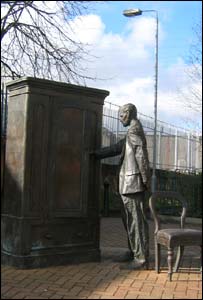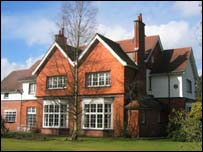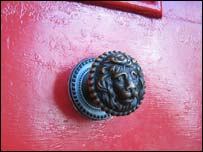
With work under way on a film of CS Lewis’ The Lion, The Witch and The Wardrobe, BBC News Online’s Greg McKevitt investigates the roots of its Belfast-born author and the Northern Ireland settings that fired his boyhood imagination.
 A statue was unveiled in Belfast in 1998, the centenary of Lewis’ birth.
A statue was unveiled in Belfast in 1998, the centenary of Lewis’ birth.
Ever since the Lord of the Rings trilogy came to the cinemas, New Zealand’s spectacular scenery has been associated with the Oscar-winning recreation of Middle Earth imagined by the books’ author JRR Tolkien.
Hoping to repeat this success, the Disney company has announced it is backing a movie of CS Lewis’ most famous tale.
The Lion, The Witch and The Wardrobe describes a war in a frozen fantasy land between the forces of darkness, led by the White Witch, and the forces of good, led by the lion Aslan.
With its fantasy setting and cross-generational appeal, Walt Disney executive Dick Cook obviously had the Tolkien adaptations in mind when he said it had “the potential to be just the start of an extraordinary series”.
Although it will be filmed in New Zealand, many believe the imaginary world of Narnia was inspired by Lewis’ childhood in east Belfast.
The author left for boarding school in England in his early teens after his mother died, and spent much of his adult life as an academic in Oxford, depicted by Sir Anthony Hopkins in the 1993 biopic Shadowlands.
However, Northern Ireland always remained in his heart, and he would return for annual holidays.
In his autobiography, Surprised by Joy, Lewis wrote: “Heaven is Oxford lifted and placed in the middle of the County Down.”
When he was seven-years-old, his family moved to Little Lea, a detached Edwardian home which still stands on Circular Road in east Belfast, privately-owned and marked only by a commemorative blue plaque.
CS Lewis’ boyhood home, Little Lea, which sparked his imagination.
Tony Wilson, Chairman of the CS Lewis Association of Ireland, said this was the home of the wardrobe where the author would hide and dream up his make-believe worlds.
“I’m sure this set off the idea in the book of opening the wardrobe and the young boy getting inside,” he said.
“Once you shut yourself inside a wardrobe, you can imagine anything.”
Lewis wrote in his autobiography that he lived “entirely in (his) imagination” during his time there.
“I am a product of long corridors, empty sunlit rooms, upstair indoor silences, attics explored in solitude, distant noises of gurgling cisterns and pipes and the noise of wind under the tiles. Also of endless books.”
Mr Wilson said some believed that Lewis got the inspiration for Narnia’s topography from the view near Stormont of the distant Mourne mountains and Strangford Lough in County Down.
But what about the lion?
The author’s grandfather was a minister about a mile down the road at St Mark’s Church in the city.
 At the old rectory, an ornate handle in the shape of a lion’s head can be found on the door, at about head-height for a child aged five or six.
At the old rectory, an ornate handle in the shape of a lion’s head can be found on the door, at about head-height for a child aged five or six.
The door knocker which some say inspired the character Aslan.
It’s not clear whether this was the direct inspiration, as the character of Aslan the lion was intended as a metaphor for the crucifixion and resurrection of Christ.
Tolkien even had an indirect influence on Lewis’ Christianity.
The two men were both lecturers at Oxford and they were close friends who shared an interest in medieval history and mythology, according to Mr Wilson.
“While Tolkien was writing the Lord of the Rings, he would meet Lewis and a number of other lecturers at a private room in an Oxford pub,” he said.
As a devout Catholic, Tolkien had an indirect effect on Lewis’ eventual conversion from atheism to Christianity, as the pair would have long conversations about religion and theology.
David Bleakley, author of the book CS Lewis: At Home in Ireland, said the two men were also fascinated by children’s imaginations.
 “Lewis had great faith in the common sense and innate decency of children,” he said.
“Lewis had great faith in the common sense and innate decency of children,” he said.
Mr Bleakley said the reason for the Chronicles of Narnia’s enduring success was its broad appeal.
“The thing about Lewis which is different to most writers is that he’s international and inter-generational,” he said.
“I think 30m copies of his books were sold in the US last year.”
In 1998, a statue was erected at Holywood Arches library in east Belfast to mark the centenary of Lewis’ birth.
The life-size bronze depicts Digory Kirke, the writer’s fictional alter ego, entering Narnia through the magic wardrobe.
Although filmmakers may look to New Zealand in conjuring up Narnia, what fired Lewis’ imagination can be found a lot closer to home.



